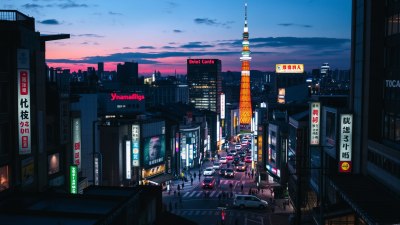Some Cities Rearrange Themselves at Night
Explore how cities transform after dark, revealing unique cultures, activities, and hidden gems.

Image created with Flux Schnell
As dusk falls and the sun sets, many cities around the world undergo a remarkable transformation. This phenomenon, often overlooked, showcases the vibrant life that emerges after nightfall. The nocturnal energy of a city can be captivating, revealing a different side of urban life filled with activities, sounds, and experiences that are distinctly different from those found during the day. While some cities are known for their nightlife and entertainment options, others take on a quieter ambiance, inviting exploration and contemplation. This article delves into how certain cities rearrange themselves at night, the cultural shifts that occur, and the unique experiences that await those willing to venture out after dark.
When discussing cities that transform at night, it’s essential to consider the settings and atmospheres that arise with the fall of darkness. In places like Tokyo, there’s a bustling energy that fills the streets as neon lights illuminate the skyline. The city’s famous districts, such as Shibuya and Shinjuku, become playgrounds for both locals and tourists. Bars and izakayas serve up delicious food and drinks while host clubs and karaoke joints create an exuberant nightlife. Tokyo's versatility means that no matter what kind of night experience one seeks, there’s something available at every corner. As the city comes to life, visitors can indulge in everything from street food to high-end dining, each offering a taste of the culture wrapped in a vibrant nocturnal package.
In contrast, cities like Paris exude romance and charm as the day fades away. The iconic Eiffel Tower sparkles brilliantly at night, and the Seine River becomes a tranquil escape, with lights reflecting on the water’s surface. The streets of Montmartre, filled with artists and musicians, come alive with performances that captivate passersby. Cafes remain open late, creating spots for intimate conversations across candlelit tables. In Paris, the night stirs creativity and connection, allowing people to feel the pulse of the city on a deeper level.
Meanwhile, cities like New Orleans resonate with a vibrant rhythm that’s deeply tied to their cultural heritage. The French Quarter, with its rich history and lively music scene, welcomes visitors with open arms as the sun sets. Jazz clubs fill with sounds that echo the city's storied past while street performers entertain crowds with their talent. Festivals and night markets further enhance the experience, allowing guests to taste local delicacies and sip on world-renowned cocktails. In New Orleans, the night is a celebration of culture and creativity, where the city seems to be alive with its own heartbeat.
New York City is another prime example of a metropolis that rearranges itself nightly, with each neighborhood offering distinct experiences. From the neon-lit madness of Times Square to the sophisticated atmosphere of the Upper East Side, the city’s atmosphere changes dramatically as evening approaches. Broadway shows and performances attract theater enthusiasts seeking entertainment, while rooftop bars provide stunning views of the skyline. Late-night food vendors serve up slices of pizza or hot dogs to those embarking on midnight adventures, embodying the ‘city that never sleeps’ sentiment. The diversity in experience allows for endless exploration as night falls.
The nightlife of cities also goes beyond entertainment; it often reflects social changes and emerging trends. Cities such as Berlin have become prominent for their nightlife, attracting a younger crowd interested in the underground scene. With techno music pulsating in clubs until sunrise and art installations illuminating public spaces, Berlin’s after-dark scene epitomizes a cultural melting pot that embraces individuality and freedom. The transformation from a busy workday to thrilling nightlife captures the spirit of a city that thrives on self-expression and the exploration of art in its many forms.
Technology has also had a significant influence on urban nightscapes. Smart city initiatives allow for enhanced safety, convenience, and engagement in nighttime activities. Cities around the globe are implementing innovative solutions, such as improved street lighting and real-time public transportation updates, to better accommodate night-time activities. This modern touch offers a sense of security to night dwellers and further encourages people to embrace the nocturnal offerings their cities provide.
Additionally, the concept of night markets has gained popularity worldwide, showcasing the culinary delights and crafts of a region. Cities like Taipei have perfected this art, where night markets buzz with energy, offering everything from stinky tofu to bubble tea. These markets not only promote local businesses but also draw tourists eager to experience the flavors and vibrancy of the city after dark. As they wander through stalls lined with colorful lights and enticing aromas, visitors are invited to enjoy a sensory adventure that captures the essence of the city.
Interestingly, not all cities thrive at night through nightlife and entertainment. Some opt for quiet and serene transformations. Consider the picturesque towns along the Amalfi Coast in Italy; as tourists retire for the evening, the streets become peaceful, and the beauty of the cliffs illuminated by moonlight reveals a different kind of charm. The quietude allows for contemplation and connection with the natural environment, giving visitors a chance to appreciate the city’s beauty in a more intimate setting.
Urban parks also undergo a change when night falls. Parks like Central Park in New York City serve as serene oases amidst the urban chaos. While some areas become hotspots for late-night joggers and picnickers under the stars, there are hidden treasures that come alive at night, like the enchanting sounds of owls and the gentle rustle of leaves in the breeze. Stargazers may find themselves marveling at the night sky, while others embark on guided night walks, revealing the magic that exists in pine-scented pathways and moonlit meadows.
Ultimately, the reinvention of a city during nighttime encourages deeper connections among its inhabitants. The shared experiences of enjoying a city under a starry sky fosters community and camaraderie. People venture out to connect - with one another, with culture, and with the distinctive rhythms of the night. This social interplay is vital as it builds relationships and memories that last far beyond the experience itself.
In conclusion, the nighttime transformation of cities presents an array of experiences that merge culture, community, and creativity into a dynamic tapestry. From the vibrant nightlife of Tokyo to the enchanted quietude of Amalfi, cities are not static; they are living, breathing entities that rearrange themselves, inviting everyone to explore their depths after dark. The energy of a city at night is infectious, urging individuals to step outside, interact with their surroundings, and discover the hidden gems waiting to be unveiled. So, the next time you find yourself in a new city, remember to take a late-night stroll; you might just find that the night holds secrets and stories waiting to be uncovered.











